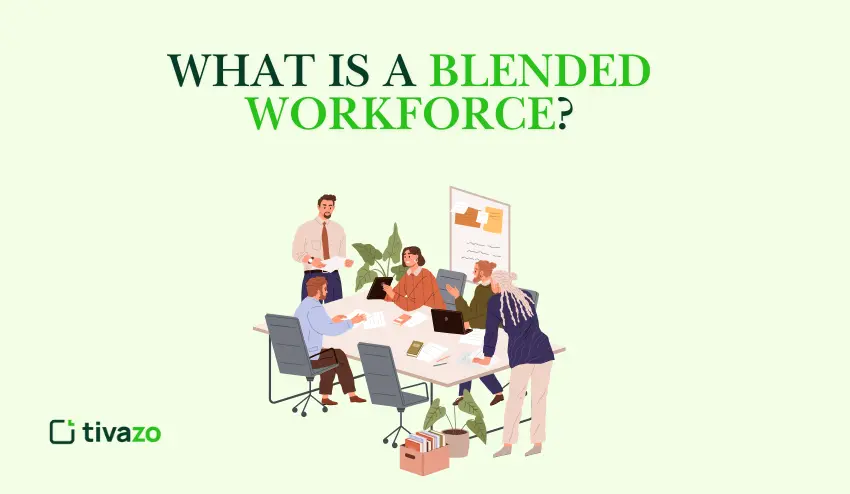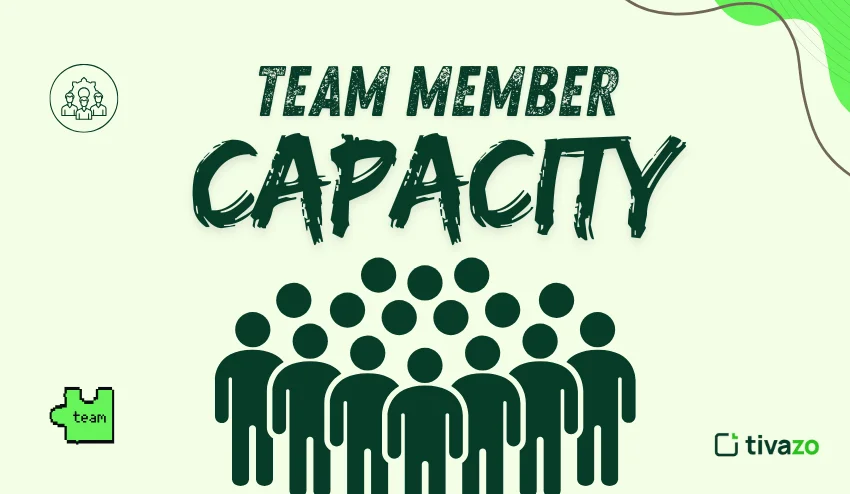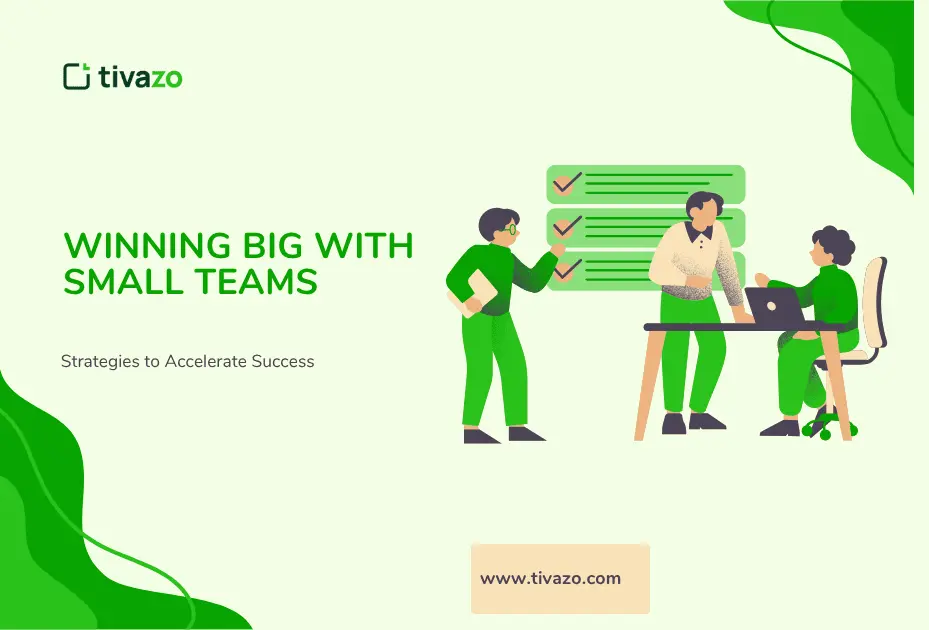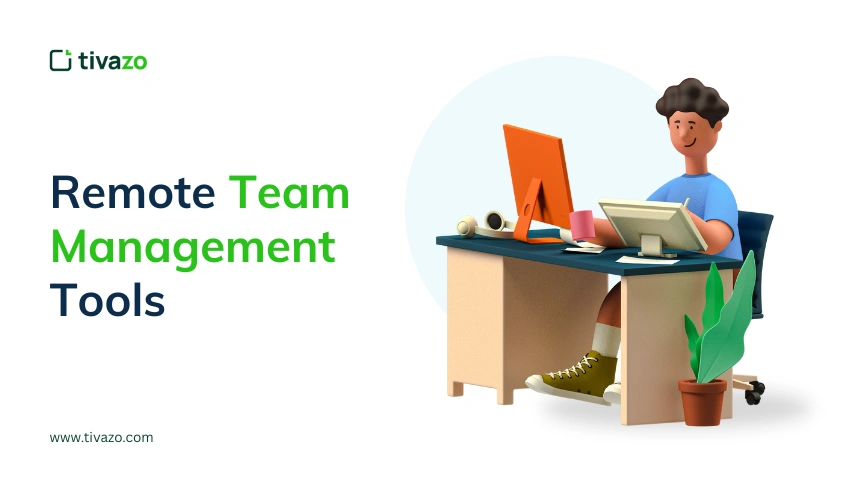Workplaces are changing at an accelerated rate. The old approach of employing full time workers is no longer applicable to the dynamic requirements of the contemporary businesses. With the changing markets and growing projects, organizations are shifting to a more flexible, scalable option, the blended workforce.
A blended workforce is comprised of full-time workers together with freelancers, contractors and temporary workers to form an agile and high performance team structure. It enables companies to react to abrupt workload alterations, acquire specialized skills rapidly, and minimize the risks of hiring. This is the solution that offers efficiency and flexibility to HR managers and business leaders, which are indispensable in the current market that is unpredictable.
The trend towards hybrid work and digital transformation in recent years has increased the adoption of blended teams. Organizations are no longer merely contemplating on the manner in which to hire but rather how to mix talent in a way that is effective. When properly implemented, this type of workforce can assist companies to be more innovative, cost-effective, and maintain a competitive edge without overworking internal staff.
This guide will discuss the definition of a blended workforce, why it is becoming a necessity, when it should be used, and how HR leaders can effectively handle such teams. You will also see, by the end, how this model can not only change the agility, culture, and long-term growth of your organization, but also how it functions.
What Is a Blended Workforce?

A blended workforce is a new form of staffing model that involves permanent workers and non-permanent employees like freelancers, contractors, consultants, and part-timers. It unites the trustworthiness of full-time employees and the versatility of on-demand talent – enabling businesses to expand fast without sacrificing quality or efficiency.
In more straightforward words, it is about the formation of appropriate talent combination. Organizations no longer rely on the traditional hiring process and are now creating teams according to the skills requirements, project requirements and business objectives. It implies that you can recruit a data analyst to work on a three-month project or a freelance designer to work on a new campaign and leave your core staff to work on strategic work.
This model transforms the approaches to talent acquisition and workforce planning to HR managers. It is not about filling the vacancies anymore but about blending the right people at the right time and the right purpose. Business executives see it as a mechanism of creating agility, controlling expenses, and tapping into specialized expertise that would otherwise be hard to obtain internally.
Nowadays, it is easier than ever to manage a blended team with the help of digital platforms, remote work, and the emergence of the gig economy. Consequently, this approach is becoming part of the workforce strategy of more organizations in the long term to be competitive and future-ready.
Why a Blended Workforce Matters
1. Flexibility and Agility
In a blended workforce, organizations are able to react faster to evolving business priorities. Companies can expand and contract teams by adding permanent staff or freelancers, contractors, or temporary employees without any long-term contracts. This flexibility makes it possible to have projects that continue even when there is sudden demand.
2. Cost Optimization
It can be costly to hire full-time workers to fulfill temporary requirements or very specialized tasks. A blended model allows the businesses to obtain the appropriate skills when needed, which will minimize overhead costs without compromising the quality of output produced. This balance is particularly useful in seasonal needs or work that is project-based.
3. Availability of Specialized Skills.
Blended teams also provide HR managers and business leaders with access to talent which might not be available in-house. Firms are able to hire professionals to work on a particular project, campaign, or technology installation without necessarily engaging them on permanent basis, and this would ensure that the work is done efficiently and effectively.
4. Risk Management
The ability to have a variety of talents minimizes reliance on a particular team or skill base. The distribution of tasks among permanent and contingent employees helps organizations to reduce operational risks and maintain the flow of vital projects even in times when the internal resources are at their limits.
5. Integration and Cooperation across Cultures.
The combination of full-time and contingent employees into cohesive culture creates knowledge sharing and innovation. A blended workforce can enhance productivity and employee satisfaction when properly done, as it will enhance collaboration among the team members.
6. Strategic Alignment
In addition to bridging the gaps, a blended workforce assists organizations to match talent to strategic objectives. HR managers will be able to spend resources effectively and business leaders will make sure that teams are agile, productive, and focused on achieving measurable results.
When Should You Use a Blended Workforce?
1.When Demand is Seasonal or Project-based.
There are high and low workloads in some industries. Retailers experience seasonal rushes and software companies can introduce product sprints. Blended workforce enables organizations to expand fast, bringing in temporary or contractual employees when there is a high demand without binding permanent resources.
2. When You Require Special or Temporary Skills.
Not all of the positions need a full-time employee. Where specialized skills or temporary assistance are required, e.g. to perform data analysis, UX design, or compliance consulting, a blended workforce will allow you to acquire the appropriate talent on demand. This would be cost-effective and projects would be implemented at the best quality.
3. When Rapid Scaling or New Markets.
New markets or pilot projects tend to need rapid, agile personnel. As opposed to recruiting permanent teams initially, businesses can implement blended teams to test solutions, collect feedback, and make changes according to real-time outcomes.
4. Where Budget Flexibility Is Important.
A diverse workforce offers financial flexibility. By paying on a per-need basis, an organization can save on labor expenses when it comes to temporary or project-based talent. This assists in maintaining the cash flow, and at the same time, the high quality expertise is available to undertake important projects.
5. Indications Your Organization Could Use a Blended Workforce.
A blended model can be beneficial to organizations that tend to experience skill gaps, often encounter project delays, spikes in workload, and market responsiveness requirements, or need specialized knowledge in the short term. Early identification of these signals enables HR leaders to make proactive plans.
Key Components & Variations of Blended Workforce Models
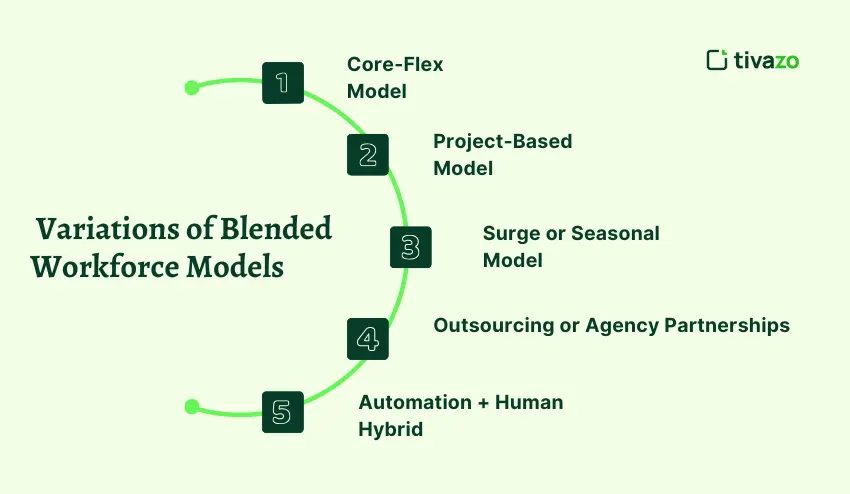
1. Core-Flex Model
The core-flex model is a mix of permanent core team and flexible pool of contingent workers. The core team takes care of long-term and strategic work, and contractors or freelancers come in to deal with short-term projects or seasonal peaks or specialized work. This model is stable and can be scaled quickly.
2. Project-Based Model
In the project-based model, teams are constructed on a project-by-project basis. Organisations hire both full-time staff and contracted professionals to provide a specific result. When the project is terminated, the temporary employees go away and the main team remains to carry on with the operations. This is a successful method especially when organizations are operating several, overlapping initiatives.
3. Surge or Seasonal Model
Certain sectors like retail, hospitality or logistics have predictable seasonal changes. The surge model enables companies to hire temporary workers in the peak seasons at a low cost as compared to permanent employees. The combination of seasonal and full-time workers ensure that the companies are productive and provide high-quality service throughout the year.
4. Outsourcing or Agency Partnerships.
Partnerships with agencies or outsourcing vendors can also help organizations develop blended teams. Outside teams are used to support core roles such as IT, design or customer support. This will help in tapping talent without adding permanent staff.
5. Automation + Human Hybrid
The blended workforce strategies are becoming more and more focused on the combination of human workers with technology and automation. Software can take care of routine tasks and human beings are engaged in strategic, creative, or complex work. This blended strategy enables the maximization of efficiency and leaves the teams with high-value initiatives.
Comparison Table: Blended Workforce Models
| Model | Composition | Best Use Case | Pros | Cons |
|---|---|---|---|---|
| Core-Flex | Permanent core + flexible pool | Ongoing operations with project spikes | Stability + flexibility | Requires strong workforce planning |
| Project-Based | Full-time + temporary experts per project | Short-term projects | Efficient, goal-focused | Temporary staff may lack cultural alignment |
| Surge / Seasonal | Core team + seasonal staff | Predictable demand peaks | Cost-effective | Can disrupt team cohesion |
| Outsourcing / Agency | In-house + external teams | Specialized functions | Access to expertise, scalable | Less direct control over external staff |
| Automation + Human | Humans + software tools | Repetitive or high-volume tasks | Efficiency, focus on high-value work | Technology costs, training needed |
7 Smart Strategies to Build a Blended Workforce
1. Planning and Segmentation of the Workforce.
A successful blended model is based on effective workforce planning. The HR managers must examine the skill requirements, project schedule, and the resource pool to identify the positions that need full-time employees and those that can be occupied by part-time or freelance talent. Segmentation makes sure that the right individuals are given the right tasks.
2. Policies & Governance
Clear policies assist in controlling compliance, contracts and expectations of all types of workers. Governance structures identify roles, responsibilities, and reporting lines, reducing confusion and legal risks. HR leaders are to make sure that contingent workers are provided with clear agreements on the scope of work, compensation, and confidentiality.
3. Unified Onboarding
A diverse workforce will perform optimally when every member of the team, irrespective of the type of employment, is recruited on a regular basis. Consistent onboarding initiatives present permanent and temporary employees to the company culture, systems, and processes, and help them collaborate and engage during the first day.
4. Performance Management
Measures of performance in a mixed workforce need to be standardized. HR managers ought to introduce assessment systems that will evaluate the results, quality, and co-operation of the permanent and contingent employees. Feedback on a regular basis will keep the accountability in check and promote continuous improvement.
5. Technology & HR Systems
Blended teams require modern HR platforms. Scheduling, communication, project management, and payroll tools will facilitate the work and ensure that all members of the team are on track. Combining these systems minimizes the administration overhead and removes miscommunication.
6. Knowledge Continuity
Knowledge may also be discontinuous in blended teams where the temporary employees may leave without any handover. Put in place documentation, handoff and mentoring procedures to make institutional knowledge available and retained by all the team members.
7. Management Change and Communication.
Blended workforces are also associated with problems of collaboration and integrating the culture. To integrate the team, establish expectations, and develop trust among all types of workers, the HR leaders must have a clear communication channel and change management strategies.
Common Mistakes & How to Avoid Them
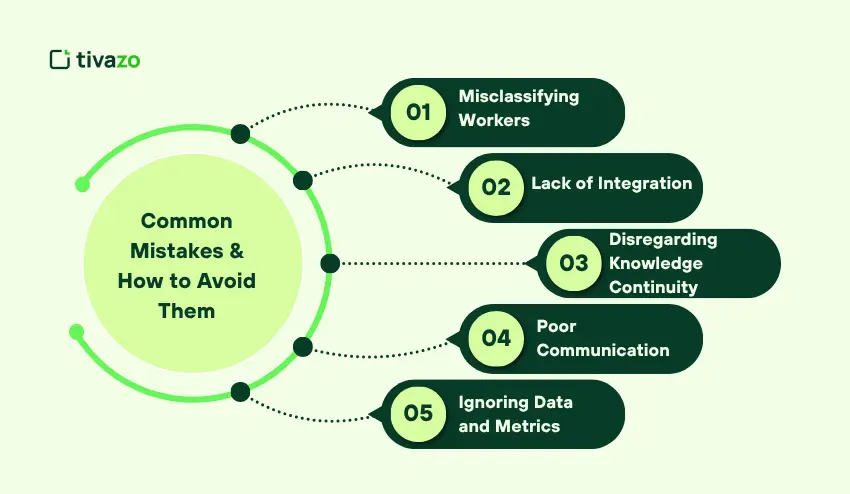
1. Misclassifying Workers
Misclassification of employees and contractors is one of the most widespread pitfalls. The need to treat freelancers like full-time employees or vice versa may result in compliance problems, fines, and legal risks. To prevent expensive errors, HR managers must specify the employment status and adhere to the labor laws.
2. Lack of Integration
A blended workforce may also have a problem of cohesion when contingent workers do not feel connected. Inability to involve the temporary employees in the meetings, updates, or company culture may decrease productivity and engagement. It is vital to integrate all the team members by using a single onboarding and communication medium.
3. Disregarding Knowledge Continuity.
Freelance or temporary employees can walk out without handing over, and the institutions will lose their knowledge. The protocols of documentation, mentorship and handoff procedures must be established to ensure that important information is not lost in the organization.
4. Poor Communication
Blended workforce tend to be geographically dispersed, in terms of employment type and schedules. Lack of proper communication may lead to confusion, duplication of work or delays. The HR leaders ought to introduce explicit communication, uniform process and frequent check-ups to ensure that everyone is on track.
5. Ignoring Data and Metrics.
It is not possible to evaluate results or gaps in services without measuring performance. Simply investing in feedback may create inefficiencies. Evaluate both permanent and contingent workers, PKI’s, and project-tracking tools all on a standardized measure of performance.
Actionable Checklist: Launching Your Blended Workforce
The blended workforce should be an introduced process that should be well planned and executed. To ensure that your organization has permanent and contingent workers, the following checklist may be employed:
1. Assess Workforce Needs
Evaluate the workload that requires full-time employees and that which can be fulfilled by contractor, freelancer or temporary employees. Identify skills gaps and project requirements.
2. Define Roles and Responsibilities.
Certainly establish job definitions, expectations and reporting lines of any kind of worker to prevent confusion and overlapping.
3. Institute Governance and Policies.
Implement contract, compliance, confidentiality and performance requirement policies to regulate risks and to streamline operations.
4. Plan Onboarding Programs
Onboarding where all the team members are involved and oriented about the company culture, systems and processes to work in harmony with the rest and create an efficient blended workforce.
5. Implement Performance Tracking.
Implement quantifiable KPIs and evaluation indicators, which will monitor the productivity, quality and teamwork of permanent and contingent employees.
6. Reestablish Knowledge Continuity.
After the documentation, hand-offs, and mentoring has occurred to pass down the institutional knowledge when the blended team works on different projects, it is best to happen live, face-to-face, remotely, or through documentation, but we must ensure it happens.
7. Foster Communication and Culture.
Be sure the blended team has open mechanisms for feedback, updates and collaboration, and work to intentionally foster the blended team connecting with one another.
8. Leverage Technology
Use HR platforms, project management software, and communication software to manage workflows to make sure that all team members are on track.
9. Review and Adjust Regularly
Evaluate workforce performance, team relationships and resource utilization on a continuous basis and make changes where necessary to make the most out of it.
10. Celebrate Successes
Congratulate the team on successes within the blended workforce to establish morale, culture as well as maintain interest in a diverse workforce.
Conclusion
The blended workforce is not only a trend anymore, but it is a strategic choice of modern organizations that aim to achieve the agility, efficiency, and access to specialized skills. With the help of full-time employees, contractors, and temporary staff, HR managers and business leaders can form the teams which will be scaled in accordance with the needs of the business, and which will be cheaper and high-performing.
A blended workforce should be implemented with proper planning, policies, effective communication, and knowledge management to achieve success. Firms which invest in onboarding, performance monitoring, and cultural assimilation will experience enhanced productivity, quicker project execution, and enhanced employee contentment.
The main lesson that can be drawn by the HR managers and business leaders is that a carefully planned blended workforce enables organizations to react to the changes in the market, address the skills shortage in a timely manner, and stay competitive. Begin by evaluating your existing workforce, determining the points of flexible talent incorporation, and adhering to a systematic implementation strategy.
Start now to review your workforce mix and create a blended workforce that will lead to growth, innovation, and long-term success.
